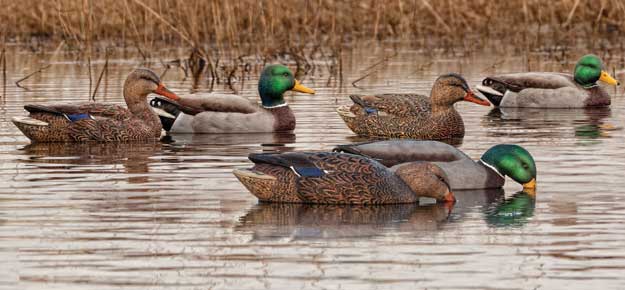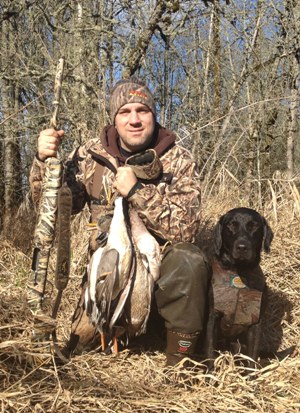ProStaffer Mario Friendy Tells the Secret for Taking Late Season Mallards

Editor’s Note: Mario Friendy of Sherwood, Oregon, is in charge of all western sales and the Zink Calls Pro Staff in Canada and is the Mossy Oak Pro Staff Regional Manager for waterfowl for the Pacific flyway. Since he was 8-years old, Friendy's been hunting ducks and geese - first with his dad in Pennsylvania where he grew up - and he’s won the Best of the West two-man duck calling championship.
Our duck season begins the second week in October and usually ends about the last Sunday in January. We have 107 days to hunt ducks. Right now in January, we’re hunting late season ducks. The Pacific flyway has many different species of ducks. In the late season, we’ll see lots of widgeon, pintails and teal.
 In the late season, the mallards are usually paired-up, in flights of 2, 4, 6 or 8. They're looking for small secluded areas that haven’t had hunting pressure all year. If you're hunting mallards at this time of the year, you'll put out decoys and do less calling. If you're hunting pintails or teal, you want to use big decoy spreads and have lots of motion in that decoy spread. You'll also want to do a lot of calling and whistling with pintail whistles. To find the mallards in the late season, start running the roads and looking for them out in fields. We’ve had a lot of sheet rain this year that has created new places for mallards. But we’re not looking for big flights of mallards at this time of year – possibly only 20 birds. When I'm hunting mallards, I use really-small decoy spreads, and I put out six or less Avian-X decoys (https://www.avian-x.com/). You want to put out the brightest and best-looking decoys you have. Usually, during the season I hide from myself six to eight brand-new decoys to have good-looking decoys for the end of the season. I put a note on the decoy box that says, “Don’t open until January.” Then I’ll put three or four of those new decoys on a jerk string to give those decoys some movement.
In the late season, the mallards are usually paired-up, in flights of 2, 4, 6 or 8. They're looking for small secluded areas that haven’t had hunting pressure all year. If you're hunting mallards at this time of the year, you'll put out decoys and do less calling. If you're hunting pintails or teal, you want to use big decoy spreads and have lots of motion in that decoy spread. You'll also want to do a lot of calling and whistling with pintail whistles. To find the mallards in the late season, start running the roads and looking for them out in fields. We’ve had a lot of sheet rain this year that has created new places for mallards. But we’re not looking for big flights of mallards at this time of year – possibly only 20 birds. When I'm hunting mallards, I use really-small decoy spreads, and I put out six or less Avian-X decoys (https://www.avian-x.com/). You want to put out the brightest and best-looking decoys you have. Usually, during the season I hide from myself six to eight brand-new decoys to have good-looking decoys for the end of the season. I put a note on the decoy box that says, “Don’t open until January.” Then I’ll put three or four of those new decoys on a jerk string to give those decoys some movement.
Even though I have a small decoy spread, I do only a very minimal amount of calling - mainly a drake whistle and some feed chatter. Every now and then, I’ll give a boss hen mallard call. The two tricks for taking a mallard at this time of year are include finding where the ducks want to be and becoming invisible. I use a Zink (www.zinkcalls.com) ATM Green Machine call, when I'm calling to the mallards. This double-reed call really sounds like a mallard. I use Avian-X Floating mallard decoys. Remember that late season mallards are very spooky. If they hear you blow a duck call, more than likely, they just about can tell you who’s manufactured that duck call. So, use your calls as sparingly as possible, stay absolutely still, and don’t move when the ducks are looking at the decoy spread. Sometimes I won’t even call. I’ll just pull the jerk string to make the decoys put ripples on the water. You can’t make any mistakes in your calling with your decoys or with your camouflage in the late season. I’ll wear Mossy Oak Shadow Grass Blades camouflage and occasionally Mossy Oak Duck Blind camo, depending on where I'm hunting and the type of terrain.
If we’re hunting sheet water, I’ll use a layout blind. In a timber area, we hunt like the waterfowlers in Arkansas by standing beside a tree and making whatever kind of blind we can. We take out time and finesse call to the ducks to try to get them as close as possible to the shooters. Usually, I won’t call the shot until I see the duck’s feet come down for landing. I shoot a Browning Maxus 3-inch Magnum shotgun, and I shoot Hevi-Metal No.2 shells made by Hevi-Shot.
Out here in Oregon, we can have in our possession seven mallards per day with two female mallards in that bag limit. You can have all mallards in your limit, or 5 mallards and two pintails. Your limit is a combination of seven ducks total.
Tomorrow: Mario Friendy: Secrets for Taking Pintails, Widgeons and Teal in the Late Season




























